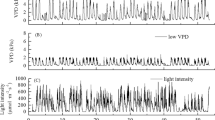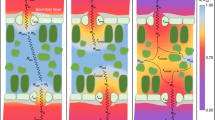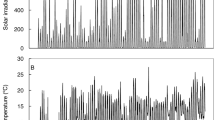Abstract
THE leaves of Agave americana are remarkable for their ability to assimilate CO2 in the dark. The maximum dark influx of CO2 (from normal air of about 320 v.p.m.) that we1 have observed is 11.8 mg of CO2 dm−2 h−1. This ability, also possessed by some other succulent plants such as the Crassulaceae, is accompanied by a night-time opening of stomata2—the so-called “inverted stomatal rhythm”.
This is a preview of subscription content, access via your institution
Access options
Subscribe to this journal
Receive 51 print issues and online access
$199.00 per year
only $3.90 per issue
Buy this article
- Purchase on Springer Link
- Instant access to full article PDF
Prices may be subject to local taxes which are calculated during checkout
Similar content being viewed by others
References
Neales, T. F., Patterson, A. A., and Hartney, V. J., Nature, 219, 469 (1968).
Nishida, K., Physiologia Plant., 16, 281 (1963).
Ransom, S. L., and Thomas, M., Ann. Rev. Plant Physiol., 11, 81 (1960).
Walker, D. A., Endeavour, 25, 21 (1966).
Renner, O., Flora, 100, 451 (1910).
Heath, O. V. S., and Mansfield, T. A., in The Physiology of Plant Growth and Development (edit. by Wilkins, M. B.) (McGraw-Hill, London, 1969).
Zelitch, I., Ann. Rev. Plant Physiol., 20, 329 (1969).
Zelitch, I., and Walker, D. A., Plant Physiol., 39, 856 (1964).
Whittingham, C. P., Coombs, J., and Marker, A. F. H., in Biochemistry of Chloroplasts (edit. by Goodwin, T. W.), 2, 155 (Academic Press, London and New York, 1967).
Gaastra, P., Meded. Landbouwhogeschool, 59 (13), 1 (1959).
Shreve, E. B., Physiol. Res., 2, 73 (1916).
Ehrler, W. L., in Physiological Systems in Semi-arid Environments (edit. by Hoff, C. C., and Riedesel, M. L.), 239 (University of New Mexico Press, 1969).
Joshi, M. C., Boyer, J. S., and Kramer, P. J., Bot. Gazette, 126, 174 (1965).
Ekern, P. C., Plant Physiol., 40, 36 (1965).
Mansfield, T. A., J. Exp. Bot., 16, 721 (1965).
Ting, I. P., Thompson, M. D., and Dugger, W. M., Amer. J. Bot., 54, 245 (1967).
Ting, I. P., Dean, M. L., and Dugger, W. M., Nature, 213, 526 (1967).
Troughton, J. H., and Slatyer, R. O., Austral. J. Biol. Sci., 22, 815 (1969).
Kluge, M., and Fisher, K., Planta, 77, 212 (1967).
Author information
Authors and Affiliations
Rights and permissions
About this article
Cite this article
NEALES, T. Effect of Ambient Carbon Dioxide Concentration on the Rate of Transpiration of Agave americana in the Dark. Nature 228, 880–882 (1970). https://doi.org/10.1038/228880b0
Received:
Issue Date:
DOI: https://doi.org/10.1038/228880b0
This article is cited by
-
Stomatal responses to carbon dioxide of isolated epidermis from a C3 plant, the Argenteum mutant of Pisum sativum L., and a crassulacean-acid-metabolism plant Kalancho� daigremontiana Hamet et Perr
Planta (1985)
-
Stomatal responses in isolated epidermis of the crassulacean acid metabolism plant Kalanchoe daigremontiana Hamet et Perr.
Planta (1981)
-
Promotion of stomatal opening in detached epidermis of Kalanchoe daigremontiana Hamet et Perr. by natural and synthetic cytokinins
Planta (1981)
-
Relationship between stomatal conductance and light intensity in leaves of Zea mays L., derived from experiments using the mesophyll as shade
Planta (1978)
-
Carbon dioxide exchange and transpiration in species of Echinocereus (Cactaceae), as related to their distribution within the pinaleno mountains, Arizona
Oecologia (1974)
Comments
By submitting a comment you agree to abide by our Terms and Community Guidelines. If you find something abusive or that does not comply with our terms or guidelines please flag it as inappropriate.



